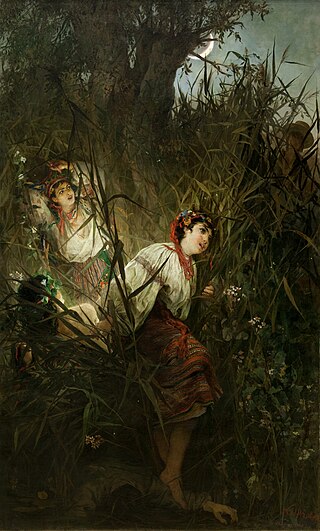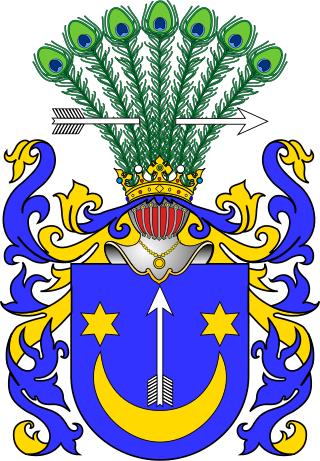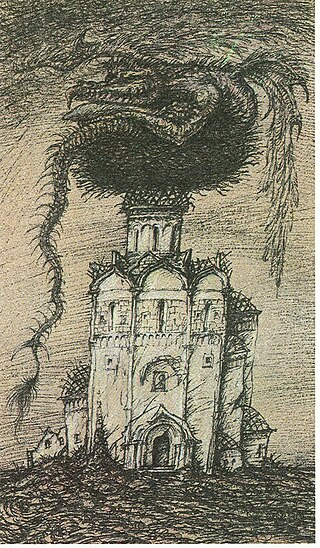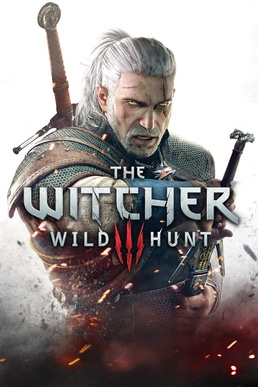Related Research Articles

Andrzej Sapkowski is a Polish fantasy writer, essayist, translator and a trained economist. He is best known for his six-volume series of books The Witcher, which revolves around the eponymous "witcher," a monster-hunter, Geralt of Rivia. It began with the publication of Sword of Destiny (1992), and was completed with the publication of standalone prequel novel Season of Storms (2013). The saga has been popularized through television, stage, comic books, video games and translated into 37 languages making him the second most-translated Polish science fiction and fantasy writer after Stanisław Lem.

The Glagolitic script is the oldest known Slavic alphabet. It is generally agreed that it was created in the 9th century by Saint Cyril, a monk from Thessalonica. He and his brother Saint Methodius were sent by the Byzantine Emperor Michael III in 863 to Great Moravia to spread Christianity among the West Slavs in the area. The brothers decided to translate liturgical books into the contemporary Slavic language understandable to the general population, and Cyril decided to invent a new script, Glagolitic, which he based on the local dialect of the Slavic tribes from around Thessalonica. After the deaths of Cyril and Methodius, the Glagolitic alphabet ceased to be used in Moravia for political or religious needs.

Ruthenian and Ruthene are exonyms of Latin origin, formerly used in Eastern and Central Europe as common ethnonyms for East Slavs, particularly during the late medieval and early modern periods. The Latin term Rutheni was used in medieval sources to describe all Eastern Slavs of the Grand Duchy of Lithuania, as an exonym for people of the former Kievan Rus', thus including ancestors of the modern Belarusians, Rusyns and Ukrainians. The use of Ruthenian and related exonyms continued through the early modern period, developing several distinctive meanings, both in terms of their regional scopes and additional religious connotations.

Other than the many gods and goddesses of the Slavs, the ancient Slavs believed in and revered many supernatural beings that existed in nature. These supernatural beings in Slavic religion come in various forms, and the same name of any single being can be spelled or transliterated differently according to language and transliteration system.

Ogończyk is a Polish coat of arms. It was used by several szlachta families in the times of the Kingdom of Poland and the Polish–Lithuanian Commonwealth.

Polish heraldry is the study of the coats of arms that have historically been used in Poland and the Polish–Lithuanian Commonwealth. It treats of specifically Polish heraldic traits and of the Polish heraldic system, contrasted with heraldic systems used elsewhere, notably in Western Europe. Due to the distinctive ways in which feudal societies evolved, Poland's heraldic traditions differ substantially from those of the modern-day German lands and France.

Sas or Szász is a Central European coat of arms. It was borne since the medieval period by several Transylvanian-Saxon Hungarian, Ruthenian, Ukrainian, and Polish-Lithuanian noble families. The house was once a mighty princely and ducal house with origins in Saxony, Transylvania, Hungary and Ruthenia.

Lech, Czech and Rus refers to a founding legend of three Slavic brothers who founded three Slavic peoples: the Poles, the Czechs, and the East Slavs, particularly Lechite Polans and Ruthene Polans. The three legendary brothers appear together in the Wielkopolska Chronicle, compiled in the early 14th century. The legend states that the brothers, on a hunting trip, followed different prey and thus travelled in different directions: Lech in the northwest, Czech in the west, and Rus' in the northeast. There are multiple versions of the legend, including several regional variants throughout West Slavic, and to lesser extent, other Slavic countries that mention only one or two brothers. The three also figure into the origin myth of South Slavic peoples in some legends. Their stories are often, to some extent as well, used as a myth to understand the eventual foundation of the Polish, Czech and East Slavic states, in accordance with the legend.

A Slavic dragon is any dragon in Slavic mythology, including the Russian zmei, Ukrainian zmiy, and its counterparts in other Slavic cultures: the Bulgarian zmey, the Slovak drak and šarkan, Czech drak, Polish żmij, the Serbo-Croatian zmaj, the Macedonian zmej (змеј) and the Slovene zmaj. The Romanian zmeu could also be deemed a "Slavic" dragon, but a non-cognate etymology has been proposed.
Polish names have two main elements: the given name, and the surname. The usage of personal names in Poland is generally governed by civil law, church law, personal taste and family custom.

Pan Twardowski, also known as Master Twardowski, is a sorcerer in Polish folklore and literature who made a deal with the Devil. Twardowski sold his soul in exchange for special powers – such as being able to summon for King Sigismund Augustus the spirit of his deceased wife – and eventually met a tragic fate.

Kajko and Kokosz or Kayko and Kokosh is a Polish comic book series by Janusz Christa that debuted in Poland in 1972 and was published primarily until 1992. Mixing history and fantasy tropes it is centered on light-hearted and often comedic adventures of two Slavic warriors named Kajko and Kokosz, loosely resembling both Asterix and Obelix, as well as two personalities from Christa's earlier series on Kajtek i Koko. The series consists of 20 comic albums, as well as a number of shorter stories published in various magazines. In 2006, a short 3D animated movie was made.

The Hexer or The Witcher is a 2001 Polish fantasy film directed by Marek Brodzki and written by Michał Szczerbic. It stars Michał Żebrowski as Geralt of Rivia. The story is based on the books and stories of The Witcher written by Polish author Andrzej Sapkowski.

The Witcher is a series of six fantasy novels and 15 short stories written by Polish author Andrzej Sapkowski. The series revolves around the eponymous "witcher", Geralt of Rivia. In Sapkowski's works, "witchers" are beast hunters who are given supernatural abilities at a young age to battle wild beasts and monsters. The Witcher began with a titular 1986 short story that Sapkowski entered into a competition held by Fantastyka magazine, marking his debut as an author. Due to reader demand, Sapkowski wrote 14 more stories before starting a series of novels in 1994. Known as The Witcher Saga, he wrote one book a year until the fifth and final installment in 1999. A standalone prequel novel, Season of Storms, was published in 2013.

The Witcher 3: Wild Hunt is a 2015 action role-playing game developed and published by CD Projekt. It is the sequel to the 2011 game The Witcher 2: Assassins of Kings and the third game in The Witcher video game series, played in an open world with a third-person perspective. The games follow the Witcher series of fantasy novels written by Andrzej Sapkowski.

Percival or Percival Schuttenbach is a Polish folk metal band from Lubin, formed by musicians due to their fascination with history and historical reenactment in 1999. The name "Percival" refers not to any historical figure, but to the gnome named Percival Schuttenbach from Andrzej Sapkowski's The Witcher series of novels. The leaders of the band are Mikołaj Rybacki and Katarzyna Bromirska. They became known for their song Lazare which was used as a song for the soundtrack of The Witcher 3: Wild Hunt video game.

Marcin Przybyłowicz is a Polish composer and sound designer. He is mostly known for as the lead composer for The Witcher 3: Wild Hunt and Cyberpunk 2077. He also composed the score to the Polish television historical drama Korona królów.

The Witcher 3: Wild Hunt – Hearts of Stone is the first expansion pack for the 2015 video game The Witcher 3: Wild Hunt. Developed by CD Projekt Red, Hearts of Stone was released for PlayStation 4, Windows, and Xbox One on 13 October 2015, later released for the Nintendo Switch on 15 October 2019, with PlayStation 5 and Xbox Series X/S versions released on 14 December 2022. The expansion is an adaptation of the Polish folktale of Pan Twardowski, following Geralt of Rivia coming in contact with a mysterious man known as Gaunter O'Dimm, and his connections to Olgierd von Everec, a cursed nobleman.

The Witcher 3: Wild Hunt – Blood and Wine is the second and final expansion pack for the 2015 video game The Witcher 3: Wild Hunt. Developed by CD Projekt Red, Blood and Wine was released for Windows, PlayStation 4, and Xbox One on 31 May 2016, and later released for the Nintendo Switch on 15 October 2019, with PlayStation 5 and Xbox Series X/S versions released on 14 December 2022. The expansion follows Geralt of Rivia as he travels to Toussaint, a duchy untouched by the war taking place in the base game, as he hopes to track down a mysterious beast terrorizing the region. The expansion received widespread acclaim from critics, winning a number of awards. Many consider it to be one of the best downloadable content packs of all time.

The Witcher is a fantasy action role-playing game series developed by CD Projekt Red and published by CD Projekt. It is based on the book series of the same name by Polish writer Andrzej Sapkowski, acting as non-canonical sequels to the story of the books.
References
- ↑ "KS. HENRYK SKOROWSKI PROTOPLAŚCI RODU JAXA BYKOWSKICH - PDF Darmowe pobieranie". docplayer.pl. Retrieved 2021-08-23.
- ↑ А. СУПЕРАНСКАЯ. "И ВНОВЬ ФАМИЛИИ НА -СКИЙ". www.nkj.ru (in Russian). Retrieved 2021-08-23.
- ↑ Maria Malec , Słownik etymologiczny nazw geograficznych Polski, 2002, p.106; for Czech names citing Jan Svoboda , Staročeská osobní jména a naše příjmení, pp. 81, 95
- ↑ В. Н Топоров , Исследования по этимологии и семантике: кн. 1-2. Индоевропейские языки и индоевропеистика, 2006,
- ↑ Władysław Makarski, Stosunki etniczno-językowe regionu krośnieńsko sanockiego przed połową wieku XIV w świetle danych onomastycznych [Ethnic and Linguistic Relation in the Krosno and Sanok Region Before the Mid-14th Century in the Light of Onomastic Data] [in:] Późne średniowiecze w Karpatach polskich. red. Prof. Jan Gancarski. Krosno, 2007, pp. 48–49, ISBN 978-83-60545-57-7
- ↑ The Witcher 3: Wild Hunt Prima Official Game Guide, 2015, p 208
- ↑ "Wiedźmin 3: Dziki Gon - Solucja i poradnik - Ostatnia posługa". Gry PC.EnklawaNetwork.pl (in Polish). Retrieved 2021-08-31.
- ↑ "Ostatnia posługa - dział: Solucja - opis przejścia/Velen i Novigrad - poboczne - wiki gry Wiedźmin 3: Dziki Gon (The Witcher 3: Wild Hunt)". MiastoGier.pl. Retrieved 2021-08-23.